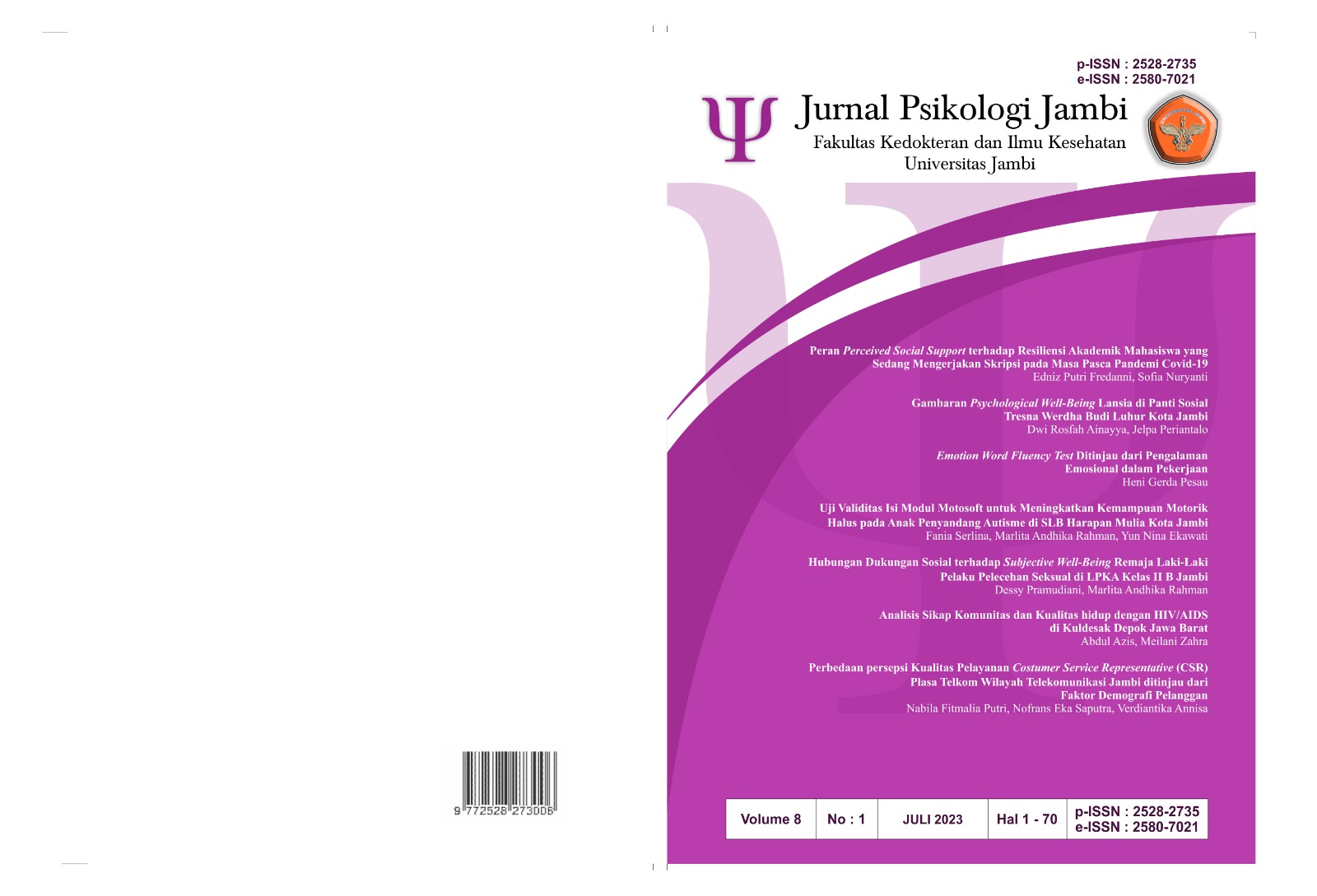EMOTION WORD FLUENCY TEST DITINJAU DARI PENGALAMAN EMOSIONAL DALAM PEKERJAAN EMOTION WORD FLUENCY TEST VIEWED FROM EMOTIONAL EXPERIENCE AT WORK
Main Article Content
Abstract
ABSTRACT
Introduction This study aimed to analyze the performance of participants in the Emotion Word Fluency Test (EWFT) through scores generated from emotional experiences at work. Fire fighters as one type of work that has risk of accidents that can trigger individual emotional experiences.
Method 90 participants were involved aged 18 – 53 years who were divided into two groups of participants (Firefighter group = 60; Staff group = 30). The EWFT scores were analyzed using the Mann Whitney Test.
The results showed that the two groups showed a significant difference in EWFT scores between the two groups on the number of correct words and negative emotion words, that the rank of the firefighter group was lower than the staff group.
Conclusions The subjective experience of participants in work can be a factor that plays a role in producing emotional words. Participants' understanding of the test instructions given also needs to be considered in scoring system.
Keywords : Emotional Word Fluency test, emotional experiences, producing emotional words.
ABSTRAK
Pendahuluan Penelitian ini bertujuan menganalisis performansi responden dalam emotion word fluency test (EWFT) melalui skor yang dihasilkan ditinjau dari pengalaman emosional yang dialami dalam pekerjaan. Pemadam kebakaran sebagai salah satu jenis pekerjaan yang memiliki resiko terpapar kejadian yang dapat memicu pengalaman emosional individu.
Metode Partisipan yang dilibatkan sebanyak 90 orang berusia 18 – 53 tahun yang terbagi dalam dua kelompok partisipan (kelompok pemadam kebakaran = 60 orang; Kelompok staf = 30 orang). Skor EWFT dianalisis menggunakan Mann Whitney Test.
Hasil Uji hipotesis menunjukkan kedua kelompok menunjukkan perbedaan skor EWFT yang signifikan antara kedua kelompok pada jumlah kata yang benar dan kata emosi negatif, yang mana peringkat rerata kelompok pemadam kebakaran lebih rendah daripada kelompok staf.
Kesimpulan Pengalaman subjektif partisipan dalam pekerjaan dapat dikaitkan sebagai faktor yang berperan dalam menghasilkan kata emosi. Pemahaman partisipan terhadap instruksi tes yang diberikan juga perlu dipertimbangkan dalam melakukan perhitungan skor.
Kata Kunci : Emotion Word Fluency Test, pengalaman emosional, menghasilkan kata emosi
Downloads
Article Details
References
Abeare, C. A., Freund, S., Kaploun, K., McAuley, T., & Dumitrescu, C. (2017). The Emotion Word Fluency Test (EWFT): Initial psychometric, validation, and physiological evidence in young adults. Journal of Clinical and Experimental Neuropsychology, 39(8), 738–752. https:// doi.org/ 10.1080/ 13803395.2016.1259396 1
Adler, A. B., Saboe, K. N., Anderson, J., Sipos, M. L., & Thomas, J. L. (2014). Behavioral Health Leadership: New Directions in Occupational Mental Health. Current Psychiatry Reports, 16(10).https:/ /doi.org/10.1007/s11920-014-0484-6
Berger, W., Coutinho, E. S., Figueira, I., Marques-Portella, C., Luz, M. P., Neylan, T. C., Marmar, C. R., & Mendlowicz, M. V. (2012). Rescuers at risk: A systematic review and meta-regression analysis of the worldwide current prevalence and correlates of PTSD in rescue workers. Social Psychiatry and Psychiatric Epidemiology, 47(6), 1001-1011. doi: 10.1007/s00127-011-0408-2
Camodeca, A., Walcott, K., Hosack, A., & Todd, K. Q. (2021). Preliminary Evidence for the Emotion Word Fluency Test as a Unique Semantic Fluency Measure. Psychological Assessment, 33(2), 195 – 200. http://dx.doi.org/10.1037/pas00009
Coleman, R. (2018). Designing experiments for social sciences. USA: SAGE Publishing.
Cornell DJ, Gnacinski SL, Zamzow A, et al. (2017). Measures of health, fitness, and functional movement among firefighter recruits. International Journal of Occupational Safety and Ergonomics, 23 (2), 198 – 204. https://doi.org/10.1080/10803548.2016.1187001.
Feldman, B. L. (2011). Constructing emotion. Psihologijske Teme, 20(3), 359–380. http:// hrcak.srce.hr /78732
Guimaraes, A., Jordao, F. (2020). Occupational stress associated with exposure to trauma in professional firefighters. 13rd Meeting of Young Researchers of Porto University.
Heydari, A.; Ostadtaghizadeh, A., Ardalan, A., Ebadi, A., Mohammadfam, I., Khorasani- Zavareh, D. (2022). Exploring the criteria and factors affecting firefighters’ resilience: A qualitative study. Chinese Journal of Traumatology, 25, 107 – 114. https://doi.org/10.1016/j.cjtee.2021.06.001.
Kusuma, R.T. (2020). Regulasi Emosi dan Kecemasan pada Petugas Pemadam Kebakaran. Acta Psychologia, 2 (2), 183-190. https://doi.org/10.21831/ap.v2i2.33358
Periantalo, J. (2017). Statistika Dasar untuk Psikologi. Yogyakarta: Pustaka Pelajar
Pesau, H. G., & Luijtelaar, G. Van. (2021). Equivalence of Traditional and Internet-Delivered Testing of Word Fluency Tasks. Jurnal Psikologi, 20(1), 35–49. https://doi.org/10.14710/jp.20.1.35-49 14. Robinson, M. D., & Clore, G. L. (2002). Episodic and semantic knowledge in emotional self-report: Evidence for two judgment processes. Journal of Personality and Social Psychology, 83, 198–215.
http://dx.doi.org/10.1037/0022-3514.83.1.198
Scollon, C.N., Koh, S., & Au, E. W. M. (2011). Cultural differences in the subjective experience of emotion: When and why they occur. Social and Personality Psychology Compass, 5(11, 853 – 864.http://doi.org/10.1111/j.1751-9004.2011.00391.x
Walla, P. (2017). Affective processing guides behavior and emotions communicate feelings: Towards a guideline for the NeuroIS community. Lecture Notes in Information Systems and Organisation, 141–150. https://doi.org/10.1007/978-3-319-67431-5_16
Wauters, L., & Marquardt, T. P. (2018). Category, Letter, and Emotional Verbal Fluency in Spanish English Bilingual Speakers: A Preliminary Report. Archives of Clinical Neuropsychology, 33(0), 444–
https://doi.org/10.1093/arclin/acx063
Yoon JH, Kim YK, Kim KS, et al. (2016). Characteristics of workplace injuries among nineteen thousand Korean firefighters. Journal of Korean Medical Science, 31(10), 1546-1552. https:// doi.org/ 10.3346/ jkms.2016.31.10.1546

